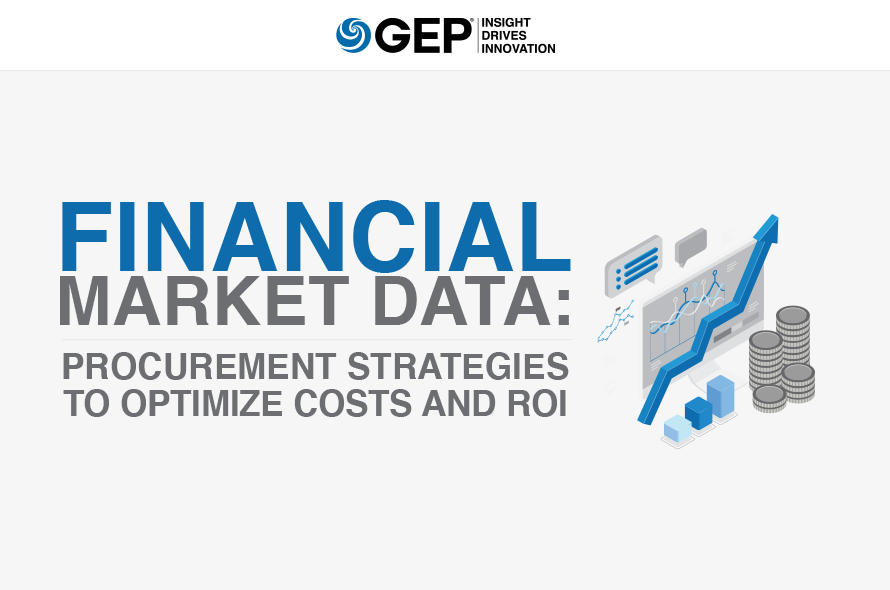-
GEP Software
-
- Procurement Software
- Direct Procurement Software
- Indirect Procurement Software
- Unified Source-to-Pay
- Source-To-Contract Software
- Procure-to-Pay
- Midsize & High Growth Enterprises
- Key Capabilities
- Spend Analysis
- Sourcing
- Contract Lifecycle Management
- Supplier Lifecycle Management
- Third-Party Risk Management
- Purchasing
- Payments
- Data Analytics and Reporting
- Do more with GEP SMART
- Intake Management & Orchestration
- Intelligent Category Management
- Tail Spend Management
- Cost Data & Analytics (GEP COSTDRIVERS)
- AI-First Supply Chain Management
- Supply Chain Visibility and Execution
- Logistics Visibility
- Inventory and Warehouse Management
- GEP Multienterprise Collaboration Network
- Supply Chain Control Tower
- Field Services
- Supply Chain Collaboration & Planning
- Supply Chain Planning
- Purchase Order Collaboration
- Forecast Collaboration
- Capacity Collaboration
- Quality Management Software
- Should-Cost Modeling
- Direct Material Sourcing
-
-
GEP Strategy
-
GEP Strategy
Unrivaled supply chain and procurement expertise + the transformative power of AI
Supply Chain Consulting
- Environmental, Social and Governance
- Sustainability Consulting Services
- Socially Responsible Sourcing
- Scope 3
- Demand and Supply Chain Planning
- Collaborative Planning
- Source To Contract
- Procure To Pay
- Inventory Strategy & Management
- Operations & Manufacturing Excellence
- GEP Total Inventory Management Solution
- Network Strategy & Optimization
- Warehousing & Transportation Management
-
-
GEP Managed Services
-
GEP Managed Services
World-class skills, experience and know-how — amplified by the power of AI
-

Financial Market Data
Procurement Strategies to Optimize Costs and ROI
Looking at your invoices for financial market data subscriptions, have you wondered if your business derives enough value to really justify the costs? You’re not alone.
External market data has become critical for core operational efficiency of financial institutions, but the increasing dependence on third-party vendors in an oligopolistic market has created complex sourcing issues. Our new white paper, Financial Market Data: Procurement Strategies to Optimize Costs and ROI, explores common challenges procurement faces and fresh strategies to improve the sourcing, management and consumption of market data services.
What’s Inside:
- Issues that make sourcing of financial market data complex
- The need for an integrated approach to manage subscriptions
- Three procurement strategies for better market data management
A must-read for sourcing and procurement professionals who want to get the most value from financial market data suppliers for their organizations.
THE ROLE OF DATA IN FINANCIAL SERVICES
Today, the financial services industry, which makes up a sizable contribution to the world’s economic activity, needs support and corroboration from key market indices for its day-to-day business transactions because of its increased dependence on data and data analytics — an upshot of globalization and digitization. In fact, that’s the case with the entire Banking, Financial Services and Insurance (BFSI) sector.
However, market data, while useful, can be overwhelming to source and manage. With financial services companies, which make a constant effort to improve their understanding of customer preferences, this data collection process is even more frequent and complex. Customer data is typically collated from two sources:
I. Internal Data Sources: These are traditional data points such as ATMs, credit cards, call centers, internet- and mobile-based sources, etc.
II. External Data Sources: These include news, industry and commercial data aggregators, trading venues and terminals, regulatory agencies, analyst reports, credit rating agencies, credit bureaus, and data from other credit and investment institutions and platforms
While establishing control over internal sources is relatively straightforward, managing external data sources, that is, third-party vendors, can be a massive and daunting task. External data holds the key to successful decision-making for financial institutions. To give an example, data on bids, asks and last traded price for financial securities enable security dealers to decide on what instruments to buy, as well as where and when to buy them.
THE PROBLEMS
While external data points are becoming increasingly critical for core operational efficiency, their management and consumption are complex and, often, not well-understood activities. Essentially, the dependence on third-party vendors is increasing, along with the costs of maintaining them. Market data poses complex sourcing issues:
Oligopoly
The market is concentrated with a handful of providers, which has created an oligopoly — a situation not beneficial to customers. For example, the Big 3 credit rating agencies control 95% of the ratings market1, while the Top 3 credit bureaus control more than 90% of individual credit information2.
This skews the balance toward the providers (suppliers) in the market. Though regulatory agencies are responsible for creating a level playing field, the impact of their decisions is long-term and seldom affects day-to-day business practices. So, while the Office of Credit Ratings (OCR) in the U.S. has designated 10 companies as Nationally Recognized Statistical Rating Organizations, the small- to mid-sized agencies are yet to gain significant market share to be at par with the three biggies.
Rising Prices
Tighter regulations, in the aftermath of the global financial crisis of 2008, have required an increased dependency on market data and analytics, driving up the general cost of acquiring these services. This rise in rates is in spite of the fact that the cost of the underlying technology has reduced significantly during the same period. For example, the cost of transmitting data has reduced to 1/15th of the cost it was a decade ago.3 Though regulations like the MiFID I-II in Europe have attempted to address this to some extent, the price of market data services has only seen an upward trend. While counterintuitive, some argue that a few of the price hikes have been because of stricter regulations, such as the need for increased audits.
Opaque Pricing
One of the larger concerns procurement faces with marketdata providers is the lack of transparency in pricing models. While data services are similar across customers, data providers use a value-based pricing model, that is, selling the product or service to the customer at its perceived value as opposed to the actual cost of providing it. Perceived value reflects the worth of the financial data to the client, and hence determines the amount the customer might be willing to pay. The pricing varies based on the client’s economic standing, the industry and the potential data usage. The BFSI sector’s strong dependence on market data for its core business dealings further fuels this lack of transparency.
Overpriced Value-Added Services
Value-added services refer to any additional analytics that providers propose for their data. These include credit assessments, risk modeling, data visualization and economic data forecasts, among other things. The convenience of receiving processed, insightful data points comes at a premium, and data providers often upsell or cross-sell products as value-added services to their raw data. Data providers are known to charge separately for the data, platform, analytics and customized solutions. Often, these charges are very high compared to the cost of customizations done internally.
Risks and Switching Costs
Both buy- and sell-side companies have integrated third-party vendor data into their mainstream processes and systems to such an extent that any effort to change the vendor bears a significant transition cost as changing data providers can result in major technological and process-related changes. Data providers also leverage the high cost of switching in the form of year-on-year cost increases and add-ons. Because of the high business dependence on third-party data, historically, market data providers are categorized as high-risk strategic suppliers, who are less prone to aggressive negotiations and disruptions.
THE SOLUTION
Cost optimization and negotiations can be challenges when buyer power is low, as with market data. For financial institutions, the challenge is not just keeping the costs down; the BFSI sector is moving toward the need to react promptly to changes in both data requirements and licensing agreements. It is less about cost savings and more about being able to fully control the impacts of those changes and leverage them in line with the business objectives of growth and competitiveness.
We suggest an integrated top-down approach to the management of data, associated subscriptions and services. The objectives are to:

I. Have visibility into when, where, how and the purpose for which the data is consumed at various touch points across the organization.
II. Ensure maximum utility and ROI from the data and analytics subscriptions, while trimming the excess add-ons.
III. Identify and segment critical vs. noncritical portions of the process and internalize data processing/customization where possible to mitigate the risk of increased dependency on third parties.
We bring you three key procurement strategies to achieve these objectives:
Demand Consolidation Across the Firm
In most companies, business units often source market data independently, driven by ad-hoc demand. This can result in overlapping data contracts, duplicated requests and unreasonably high data costs. A centralized sourcing strategy can help drive down operational costs, while company-wide subscriptions could lead to volume discounts.
Subscription Rationalization
The nature of the BFSI sector, with its constantly changing regulations, promotes significant upselling by data providers. Businesses may find themselves overwhelmed with subscriptions and their management. It may seem cumbersome, but it’s important to keep track of service usage and ROIs in a dynamic environment like the BFSI. While bundled subscriptions offer better discounts, it’s vital to note that the value of the add-on products might not always be on par with the additional cost incurred.
A strong compliance process must be in place to understand specific business needs and encourage subscription to products/modules that guarantee value-addition, while eliminating obsolete services. Specialized or custom-built tools available for data and subscription management can be evaluated and the one most suited to the company’s needs can be used.
Controlled Access and Continuous Monitoring
While the first two levers control the flow of data and services into the company, an even more important lever is the management of the distribution and consumption of data and related services within the organization. The first step here is to get visibility into this process, which can be achieved through multiple methods based on the size of the company and the scale of distribution of data:
- A centralized repository with access to limited personnel
- A tool through which access and usage is monitored
- A separate shared service function that internally processes data and shares analytics/insights to business users
COUNTERACTING POWER AND DEPENDENCY WITH CONTROL
The financial market data industry has high supplier power, and this status quo is unlikely to change in the near future. While there is no over-the-counter solution that can be prescribed for the entire spectrum of financial institutions, procurement can in many ways enable better management of data services. Active control of demand will counterbalance the higher supplier power and help maximize ROI from data subscriptions. The scale of the organization and its core business needs must be taken into consideration while designing a system for management of financial market data. Ultimately, any solution must be pivoted on the twin objectives of complete visibility and maximum utility.
1 “Credit Rating Agencies Are Back Under the Spotlight,” The Economist, May 2020
2 “Break Up the Credit-Reporting Racket,” The New Republic, Sept. 2017
3 Chapter 2, DrPeering.net, 2014
To download and read,
Please Enter your EMAIL
JUST A FEW MORE THINGS ABOUT YOU
Breadcrumb
- HOME
- WHITE PAPER
- FINANCIAL MARKET DATA: PROCUREMENT STRATEGIES TO OPTIMIZE COSTS AND ROI










